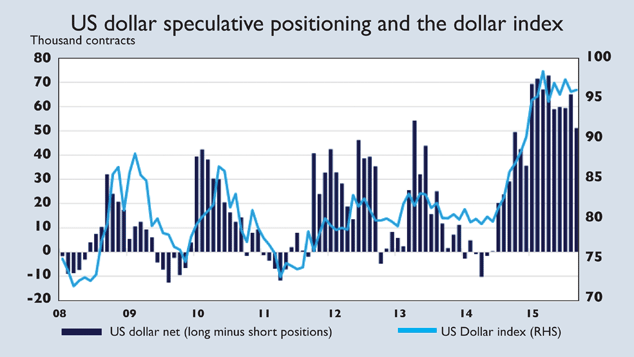
There are two good reasons to expect the US dollar to strengthen further. The first is that the US economy might awaken from its slumbers and churn out another impressive burst of growth. In that case, members of the US Federal Reserve’s interest-rate setting committee would appear as bumbling Keystone Cops, way behind the game. The front part of the US yield curve would steepen to reflect a faster pace of tightening than that currently priced in, boosting the positive carry into US dollars out of euros and yen (in other words, traders could earn higher interest payments by swapping their euros and yen for dollars, driving the dollar higher).
The second good reason would be if market confidence, already frayed after a bruising August, was shattered by news of a big bank in trouble – perhaps one with strong Chinese connections – or a full-blown emerging economy crisis. In this case, the US dollar would seem compelling as rumours of so-called ‘dollar shortages’ spread like wildfire.
It might never happen
But in the likely event that neither of these dramas plays out, there is a credible argument for the unravelling of last year’s US dollar strength. Positioning in the US currency has retreated from its extremes (as the chart shows, fewer people are ‘long’ the dollar than they were) and is heading lower. Now that Greece has been granted its third bailout and peace has broken out in Europe, what is the urgent reason to prefer US dollars?
Yes, the Japanese economy is in the midst of one of its agonising pauses, but the prime minister, Shinzo Abe, and the central bank chief, Haruhiko Kuroda, show no sign of being panicked into further money printing. And as far as it is possible to know, China is selling US government bonds at an unprecedented pace as a logical extension of its net capital outflow. The absence of a fresh motive to accumulate US dollar positions is sufficient basis for a reversal of fortunes.
The 20% surge in the dollar’s value since last summer, not least against the Chinese yuan, the Brazilian real and the Indian rupee, is making life increasingly uncomfortable for global corporations headquartered in the US. Over 30% of US net profits are generated in emerging-market currencies, so a strong dollar amounts to a wealth transfer to the rest of the world. A rebound in US growth in the April-June quarter seems not to have followed through into this one.
The Atlanta Fed estimates a measly 1.5% growth pace based on data posted to date. The failure of the oil price to sustain its summer rally has triggered further cancellations and postponements of US energy-related capital spending.
We’re still waiting for lift-off
Meanwhile, the long-awaited lift-off of US interest rates remains long-awaited. Speculation that the Fed will act at its mid-September committee meeting has abated in recent weeks for a variety of reasons. The Fed – and the Bank of England for that matter – is dread-locked: imprisoned by the dread of making a policy mistake that will go down in the annals of history as a classic blunder. Vice-chair Stanley Fischer shocked listeners at Jackson Hole with the revelation that American policymakers are paying close attention to events in the rest of the world.
Will China’s economic dislocation put paid to the 2015 rate rise? There is also a smarty-pants scenario in which Fed chair Janet Yellen raises the funds rate and the interest on excess reserves, but by a miserly ten or 15 basis points, rather than the regulation 25 (0.25%). Either way, this rate rise is likely to be an only child.
Does this sound like a confident march towards the normalisation of rates after more than six years in the wilderness? Hardly. The market’s expectations for future US interest rates today are a pale shadow of those that helped propel huge inflows towards the dollar last year.
Who’ll be next in the White House?
Last, but not least, we should consider the impact of the approaching 2016 presidential election. A feature of the American constitution is the limitation of a president to two terms of office. In November next year, America will elect a new president and no one I meet seems very sure who that will be. Hillary Clinton is the comfortable favourite (11/10 against – though if you feel lucky, you might opt for Kim Kardashian at 1000/1). The Republicans are still toying with a field of 20 potential nominees, among whom Jeb Bush (13/8 against) is out in front, but with Donald Trump (7/2) surging forwards.
So here are the questions: how well will foreign capital be treated under a Clinton administration? What will be the attitude of her administration towards the financial sector in general? Her proposed changes to capital gains tax would raise the rate to 43% for investments held for less than two years. Will the US descend into protectionism? Will the Fed’s wings be clipped? Will relations with China turn sour? Will there be a rethink on welfare? Will there be a reappraisal of the unconventional energy sector? And given these questions – will investors still prefer the US dollar?
• Dr Peter Warburton is director of Economic Perspectives Ltd.